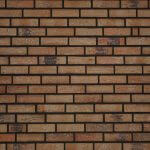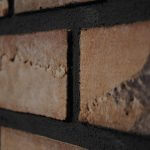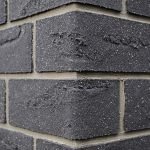Flexible tiles are made of specially graded quartz sand with a help of unique technology. The main mass is mixed with liquid colour resistant to ultra-violet rays.
Polyacryl solution is used as a binding material. This product looks like clinker. Due to their special qualities these tiles can be laid on all dry, clean and flat surfaces and insulation systems. It is important to mention that decorating interior or exterior with these tiles you do not need corner tiles, special working tools or double armouring. Flexible tiles will make your house look aesthetically nice and require much less expenses than clinker.
Technical specifications:
- Materials: specially graded quartz sand;
- Binding material: polyacryl solution;
- Colour: wet painting on the base of iron oxide;
- Organically bound concrete free flexible tiles that can be fixed on corners without any additional corner components;
- The weight of decoration tile is only 4kg/m2 ;
- The width of a tile is only 4 mm;
- Tiles can be easily cut with scissors or a sharp knife;
- 100 % productivity;
- Resistant to mechanical damage;
- Washable;
- Permeability to air;
- Cladding becomes hard only after fixing;
- No special preparation needed.
Gluing:
- The surface should be firm, dry and clean without any fat. The surfaces made of sand (cement, concrete or plaster) should be primed;
- In order to reach the best result it is necessary to use special glue. Always start from upper wall or surface detail. Glue should be spread with a help of 4 mm applicator (comb). Do not cover a big area because glue starts freezing in 10 minutes;
- Using glue inside take care of floor protection;
As tiles are thin you do not need additional materials to make off joints. You need only to go over the joints with a 10-12 mm width brush. Make sure that tiles are properly glued and that water or moisture cannot penetrate under already glued tiles.
Necessary tools:
- A pencil, a ruler and a level: to draw lines;
- A thread: to draw a straight line;
- 4 mm applicator (comb); for glue spreading;
- Scissors: to cut tiles of the right size;
- 12 mm width brush: to seal joints.
Important to know:
- Vertical and horizontal joints should be 10-12 mm width. Smaller joints will require more tiles;
- Always start gluing tiles from above;
- Make sure that drawn lines are straight;
- Take tiles from different packaged in order to get the best colour effect;
- Never use tiles close to open flame;
- Always keep 15 m distance between tiles and heating elements;
- Slight colour changes are possible if you buy additional tiles (due to special sand);
- After gluing these tiles should be protected from rain for 5-7 days;
- Do not glue tiles at a temperature below+5 C;
A buyer should always check if a surface where he wants to glue tiles is suitable.






